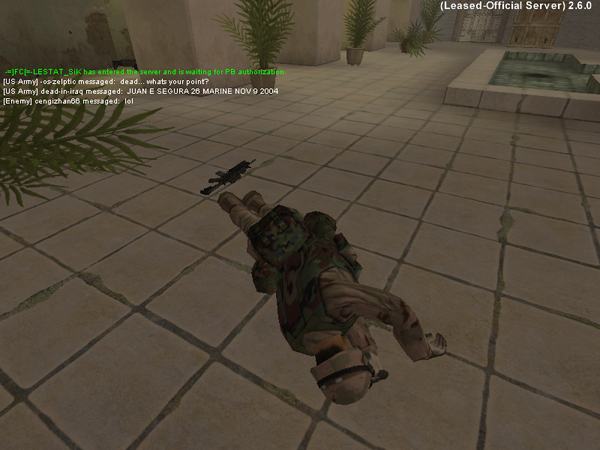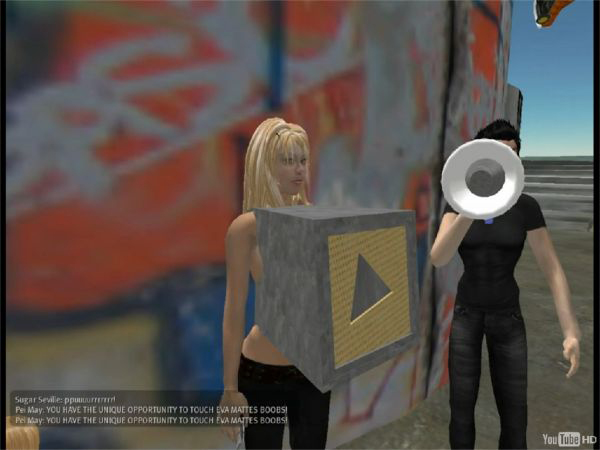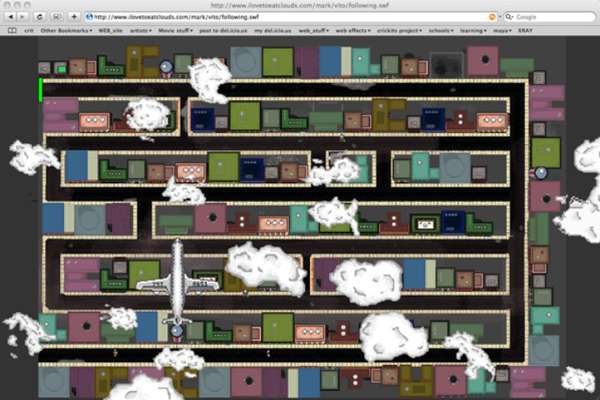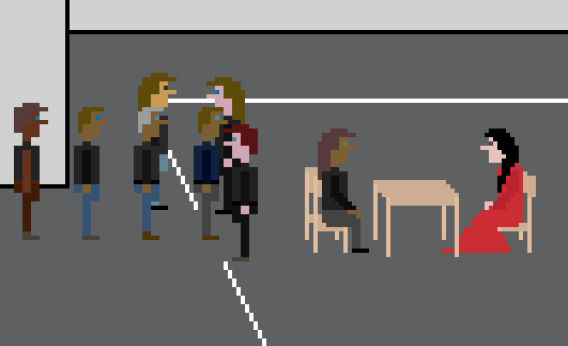Performance art emerged in the mid-1960s into the 1970s and was a way to push the boundaries between art and everyday life. Many artists saw performance as an opportunity to bring art directly to the audience without having to detour through the galleries, curators or agents. Performance therefore often occurs outside the institutions on streets, squares or other public places. It was defined as an antithesis to theatre and the ideal was to "create an ephemeral and authentic experience for performer and audience in an event that could not be repeated, captured or purchased."(1)Famous performance artists from this time are Yoko Ono, Joseph Beuys, Vito Acconci, Chris Burden and Marina Abramović.
With that background it's not surprising that performance artists today explores computer games and online worlds. These new digitals worlds gives the artists an opportunity to meet a new public and basically bring their art into peoples livings rooms. With help of the Internet they can also reach a new and broaden art public all around the world. Online performance started in the early text based systems as MOO, MUD and chat rooms and have followed the technology development into 3D online worlds. One thing that surprised me when I did this survey was that so many artists have chosen to re-enacted famous performances from the history of art in different videogames and on-line worlds. To be witty you could say that many of these old performances have got a second life in Second Life.
Antoinette LaFarge
One of the first attempts to explore performance on-line was made by Antoinette LaFarge, an American new media artist and professor of Digital Media at University of California Irvine. In 1994 she founded the "Plaintext Players", an online performance group inspired by MOO. MOO (a cousin to MUD-Multi-User Dungeon) was a system used to create online text-based adventure games in the beginning of the nineties. In an interview I did with Antoinette LaFarge for Gamescenes in October 2011 she told me how she got involved in MOO performance from the beginning:
"I got involved with MOOs in early 1994 while I was in graduate school. I was initially entranced by the immersive quality of these spaces and the way they straddled a line between performing and being, and between writing and doing. From the outset I had a strong impulse to play in MOO, to make up stuff, to not take part under my own name and history. Some of my fellow students had a similar impulse, and at first we would just meet up online and improvise very loosely. For instance, we might change our avatar names (@rename) 4 or 5 times an hour just to prod each other to change how we were interacting. We were the puppetmasters and the puppets."(2)
The first performance by "Plaintext Players" was called "Christmas" and was a series that took place online on PMC MOO between the first of March and the 18th December 1994. The series was based on a scenario by Robert Allen featuring the archetypal character trio: Big Man, Little Man, and Bloody Zelda. During the year that the series run, the ill-assorted trio found themselves in court, in hell, and lost in the desert as they played out their struggles.(3)
Joseph DeLappe
During the nineties the online game world was rapidly changing from text based adventure games into action games with 3D graphic worlds. The game Doom from 1993 started a new popular genre The First Person Shooter and the multi-player mode was a precursor to many on-line games in the genre. In the middle of the nineties with the expansion of Internet on-line gaming became a more and more popular occupation for gamers. These new scenarios opened up new opportunities for artists. One of the pioneers in this context is the American artist Joseph DeLappe who started with online gaming performance in 2001:
"It was in the spring of 2001 that I engaged in my first online gaming performance – 'Howl: Elite Force Voyager Online'. I entered the game as Allen Ginsberg and proceeded to perform the entirety of his seminal beat poem 'Howl', word for word."(4)
Many of DeLappe's works have an anti-war theme. In the war game "Medal of Honor: Allied Assault" Delappe mixed an antiwar message with poetry. He logged into the game and started to read poetry from war poets as Siegfried Sassoon by typing the poems in the games chat field.(5)Sassoon was a British poet who wrote satirical anti-war poetry during World War One.
DeLappe's most notable work is otherwise a performance that began in March 2006 on the third anniversary of the Iraq war. "Dead-in-iraq" is the title of the work but also DeLappe's alias when he logs in to the game "America's Army". "America's Army" is an online game that functions as a recruitment platform for the U.S. military. In the game DeLappe drops his weapon and start typing the names of all the American soldiers who died during the Iraq war. The performance ended the 18th December 2011 which was the official withdrawal date of the last U.S. troops in Iraq. Delappe had then entered total of 4484 names in the game.(6)
 |
Joseph Delappe "dead...whats your point?" dead-in-iraq screenshot (2006-2011) |
These anti-war performances often create strong reactions from the other players. The poems and the name of the killed soldiers remind the players about the reality of war, which both make them angry and uncomfortable. The players ask DeLappe to stop what he's doing, but when he continues they shoot him or simply kick him out of the game. You can see the strong reactions from the other players as a proof that Delappe's performance are successful. He succeeds to break the game illusion, in the same way as Brecht "Verfremdungseffekt" breaks the illusion in drama. Brecht wrote that the distancing effect ("Verfremdungseffekt") "prevents the audience from losing itself passively and completely in the character created by the actor, and which consequently leads the audience to be a consciously critical observer."(7) or as DeLappe explains:
"I see these works as a way to break through and perhaps expand the notion of "the magic circle" in gaming. We do not 'play' in contexts that are unrelated to our political, social and economic realities. Reactions during the first performance, "Howl" were mostly humorous. I recall one player noting 'wow, poetry and shooting!'. Reactions to my work have been most fierce within the context of the ongoing project, "dead-in-iraq", commenced in 2006. Other players routinely insult me, demand to know why I am doing what I am doing and are generally very hostile."(8)
There are two more performances I want to mention when talking about DeLappe. The first "Quake / Friends" took place on 18th October 2002 and consisted of six people linked up online at the same venue in the game Quake III. In the game they began to perform an entire episode from the series "Friends." It was done by each participant played a character in the series and then wrote up his lines in the text field that is used by players in the game to communicate with each other. Since Quake is a game about killing as many opponents as possible to win, the performance was constantly interrupted when one of the participants was killed by the other players and he was then forced to re-emerge to continue the performance.(9)
The performance was mentioned in an article in the New York Times, which led to Warner Bros., who owns the rights to the series "Friends", sent a letter to DeLappe in which they warned of legal action if DeLappe continued to use copyright protected material from the series "Friends" in his performances. In a settlement DeLappe refrained from carrying out the plans for a "Quake/Friends.2" performance. Instead DeLappe staged his "Quake / Friends" performance again on the 8th March 2003. This time the performance was made live in an art gallery. At six computers sat the participants logged into Quake, and their screens were projected on the gallery wall so anyone who was in the gallery could follow the performance live.
The other online performance is "ET tu?, Alfred" premiered in November 2003 and was played out in the computer game "Aliens Vs. Predator." The dialogue was in this case lines from Spielberg's film "ET: the Extra Terrestrial" and statements made by the Iranian refugee Merhan Karimi Nasseri (Sir Alfred)(10)who for 15 years of age lived as an illegal refugee in Paris airport. Spielberg made 2004 the film "TheTerminal "with Tom Hanks in the lead role, based on the history of Karimi Nasseri. Both the alien ET and Sir Alfred are in a sense stranded refugees who are trying to find a home which is a subject that DeLappe focus on in this performance.
Eva and Franco Mattes aka 0100101110101101.org
In 2003 the Linden Labs started the online world Second Life which gave artists new possibilities to create on-line performance. Second Life is a 3D virtual world with its own currency and economy. For your money you can buy land, build houses, organizing art exhibitions, yes, anything you can do in real life you also can do in Second Life, and more. The freedom to build and create your own world soon made Second Life an important platform for artistic experiments. In 2006 one of the first performance groups in Second Life was founded. Secondfront.org consist today of seven members Gazira Babeli, Yael Gilks, Bibbe Hansen, Doug Jarvis, Scott Kildall , Patrick Lichty and Liz Solo.(11)You could probably write a whole book about Secondfront.org and performance art in Second Life, but in this survey I have chosen only to look closer to another artist group working with performance in Second Life.
Eva and Franco Mattes aka 0100101110101101.org calls their performance series "Synthetic Performance" which are described on their homepage as:
"Synthetic Performances are online live gaming sessions inside the virtual world of Second Life, performed by Eva and Franco Mattes through their avatars, which were constructed from their bodies and faces. People can attend and interact with the live performances connecting to the video-game from all over the world. "(12)
In 2007 they started to re-enact several important performances from the history of art. "Shoot" from 1971, where the artist Chris Burden got shot with a rifle by a friend. Acconci's "Seedbed" from 1972, when the artist was hidden under a ramp in the Sonnabend Gallery and masturbated while he described his fantasies about the visitors who walked on the ramp above him. Valie Export and Peter Weibel's "Tap and Touch Cinema" which took place at various locations in Europe during 1968-71. "Tap and Touch Cinema" consisted of a box with a curtain which the artist Valie Export wore in front of her naked torso. This portable cinema was a protest against the way women and sexuality were described in movies. The crowd on the street were invited to visit Valie's cinema and could put their hands behind the curtain and feel the "movie", that is her breasts. The audience was no longer only a passive observer who saw the woman as an object in the cinema but had to be able to act and decide what "appeared" in Valie's movie theater. Another re-created performance by Eva and Franco Mattes including nude bodies was Marina Abramović and Ulay's "Imponderabilia" originally performed in 1977, a performance in which the two artists stood naked in a narrow corridor at the main entrance to the art museum in Bologne. The visitors had to squeeze themselves between the two naked bodies to enter the exhibition.
 |
Eva and Franco Mattes aka 0100101110101101.ORG Reenactment of Valie Export and Peter Weibel's Tapp und Tastkino, (2007) |
Performances in Second Life and other on-line games are performed by avatars actors. An avatar is a graphic character representing the player in a virtual world. The above mentioned performances are originally about the body and are very tactile, that is, the visitor is confronted with a situation that might arouse discomfort. A man gets shot, someone is masturbating, an unknown woman offers the audience to feel her breasts or the visitor has to squeeze himself between two naked bodies. When these works are re-created in a virtual world several important senses are missing as smell, heat, skin contact etc. To see an avatar that being shot or passing between two naked avatars with your own avatar is far from the same experience as in real life. Eva and Franco performances therefore arouse other questions. Why are people for example acting different in a virtual world when they are represented by an avatar than they are acting in real life? Marina Abramovic and Ulay's performance "Imponderabilia" and Eva and Franco's re-enacting are basically the same concept, the only difference is that one is staged in reality and the other in a virtual world. Despite that, the context is so different that it will be two total different performances that the visitor will be experience.
In the "Synthetic Performance" series from 2007 you can also find Joseph Beuys work "7000 Oaks" re-enacted in Second Life. It all began in 1982 at the Documenta 7. With help of volunteers Beuys started to plant 7000 oaks in the German city Kassel and each tree was accompanied by a basalt stone.(13) 25 years later Eva and Franco made the same art installation in Second Life. They started to plant virtual trees and stack boulders on an island in Second Life. The project will end when 7000 oaks and stones are planted and placed out in the virtual world. The last performance from 2007 is the "Singing Sculpture" which was first performed in 1969 by artists Gilbert & George. It was a performance in which Gilbert & George simply stood on a table and danced and sang to the song "Underneath the Arches". Almost 40 years later Eva and Franco's avatars performed the same song on a virtual table in cyberspace.
In 2009-2010 Eva and Franco presented three new performances in the synthetic performance series. "I know that it's all a state of mind", "I can't find myself either" and "Medication Valse". These performances are also about body and nudity, but the big difference is that Eva and Franco are now using the full repertoire that the virtual worlds as Second Life provide for body or shall we say avatar performances. In a virtual world you can change the rules of the world by hacking and modifications and allow your avatar to do things that are impossible for bodies in the real world. As anti-gravity, flying, bending and transforming the body of your avatar in unnatural position and using glitches in the program to make your avatars fall into others avatars or walk into object that should be solid.
Rainey Straus and Katherine Isbister
Rainey Straus and Katherine Isbister made 2004 a performance that they called "SimBee", which they describe as a parody of the artist Vanessa Beecroft's installations recreated in the game "The Sims".(14) "The Sims" is a simulation game where players can create their own family and then let the family move into a house in a virtual community. The task is to ensure that all members of the family are happy and contented. One could compare "The Sims" to an advanced virtual dollhouse. Vanessa Beecroft, on the other hand, is an Italian artist who has worked with performance art in museums, where she makes use of scantily clad female models who poses in the exhibition space as a sort of living Barbie dolls. Beecroft works in the intersection of fashion and art, and often focus on how we view people. In "SimBee" Straus and Isbister staged an installation of Vanesse Beecroft in a virtual gallery, but after a while the Sims models start to live their own life and the performance degenerates in a disastrous way with fires, fights and violence. In an interview Ibister explains why she and Straus choose to use a videogame as Sims for performance art:
"Games invite our participation and projection--we are actors in these virtual spaces, and they are such plastic, malleable worlds. They are a tremendously powerful venue for exploring issues of representation, of identity, of control of our own image, as well as issues of aesthetics and how our senses are framed by the context in which we experience art. The Sims itself is a world in which these kinds of explorations are happening on a mass scale for everyday consumers, and was a ripe context for conducting such investigations."(15)
 |
Rainey Straus and Katherine Isbister, Simbee (2004) after Vanessa Beecroft |
Another artist that have been working with "The Sims" are the American artist Caleb Larsen. In Caleb's case it was not a re-enacting of a pervious performance but a new one with himself in virtual version in the lead roll. Caleb reconstructed as far as it was possible with the Sims technology, elements of his life, family, apartment and neighbourhood in the game. He also created an avatar, a virtual character with a life similar to his own. In June of 2005 the performance, with the title "Simulacrum" was performed in the Tjaden Gallery at Cornell University. For one week Caleb acted as his virtual self from 9:00 am to 4:30 pm in the virtual world of Sims. During the exhibition he maintained a weblog documenting his life by posting screenshots and captions from the game. On his homepage Caleb explains that the inspiration to "Simulacrum"came from artists as Allan Kaprov and Tehching Hsieh.(16) In the sixties Kaprov made happenings as "Eighteen Happenings in Six Parts" where the audience was invited to share experience in which he had incorporated everyday activities.(17) The American artist Tehching Hsieh also mixes art and real life. He has performed a couple of "One Year Performance"(18) in which he during one year lives after fixed rules that he for example is not allowed to go indoor, talk, make art etc. Larsen's "Simulacrum" is also a mix of art and life, but in this case a virtual life. The audience can in "Simulacrum" take part of the artist's virtual life during a week.
Mark Beasley and Pippin Barr
As an artist you don't have to use existing videogames or on-line worlds to re-create famous performance, you have always the possibility to create your own game. The American artist Mark Beasley created 2007 "Vito Acconci (The video game) "a suite of three new video games in which the player can re-enact famous performance by Acconci as "Seedbed", "Center" and "Following Piece".(19) In these games it is not Beasley who is re-enacting the performance, instead it's the player. With help of a Wii-remote control the player can play the roll as Vito Acconci. In "Following Piece" for example Acconci during a month selected randomly a person he met on the street and started to stalk him until he entered a private place.(20) In Beasley's game your goal is to stalk a person on the street but if the distance to the person is too long you will loose the game and have to start all over again.
 |
Mark Beasley's "Vito Acconci (The Video Game)" (2007) screenshot from Following Piece |
In the videogame "The Artist Is Present" Pippin Barr re-created a performance by the artist Marina Abramović which she did at the Museum of Modern Art in New York 2010. As in Beasley's games the graphic is simple and reminds of the early 2D 8-bit games from the eighties. In Abramović performance nothing much happens, people are queuing for hours for the opportunity to sit for a couple of minutes in front of the artist at a table. The game is therefore basically about waiting. Waiting for the museum to open, waiting in the queue to meet the artist eye to eye. On the other hand waiting is essential part of our life which Samuel Beckett so well has described in his drama "Waiting for Godot" or as Barr describes his game:
"Waiting is such a no-no in games […] it's regarded as so abusive, and yet it's a major part of life. To the extent we want games to (sometimes) be »about life«, waiting is fair game."(21)
 |
Pippin Barr "The Artist is Present" (2011) after Marina Abramović performance at MOMA 2010 |
Conclusion
Since the sixties performance artist have tried to explore and find new groups and arenas outside the established art institutions. With the development of Internet and on-line worlds artist started to use avatars actors to create performance and meet a new public from all around the world. The artist Joseph Delappe tries in his performance to establish a dialogue with the gamers by interfering and breaking the illusion in the game. Eva and Franco Mattes and other artists re-enact classic pioneers works from the sixties in digital environment. An essential part of in real-life performance is to explore the body and the conventions and the taboos that are associated with the interaction of people. Many of these classic performances that artists today re-enact in on-line worlds is tactical and tries to affect or shock the visitor. But in the virtual world there are another set of rules and we behave in different ways since we are aware this is only a fiction. You can shoot people, go around naked and do other things that are not accepted in the real world without people are shocked. These new context create a new meaning to the performances in on-line worlds. Instead of breaking the rules of human behavioral many of the these performance or re-enacting of performances tries to break the rules of the game. In DeLappe's case he breaks the players illusion by reminding them that there are a real war outside the virtual world. Pippin Barrs game "The Artist Is Present" is mainly about waiting which is against a fundamental rule in games. If real life performance is mainly about our bodies then on-line performance is more about breaking the illusion and the rules of the virtual world or game to make us aware that we are in an artificial world.
|

![]()

![]()